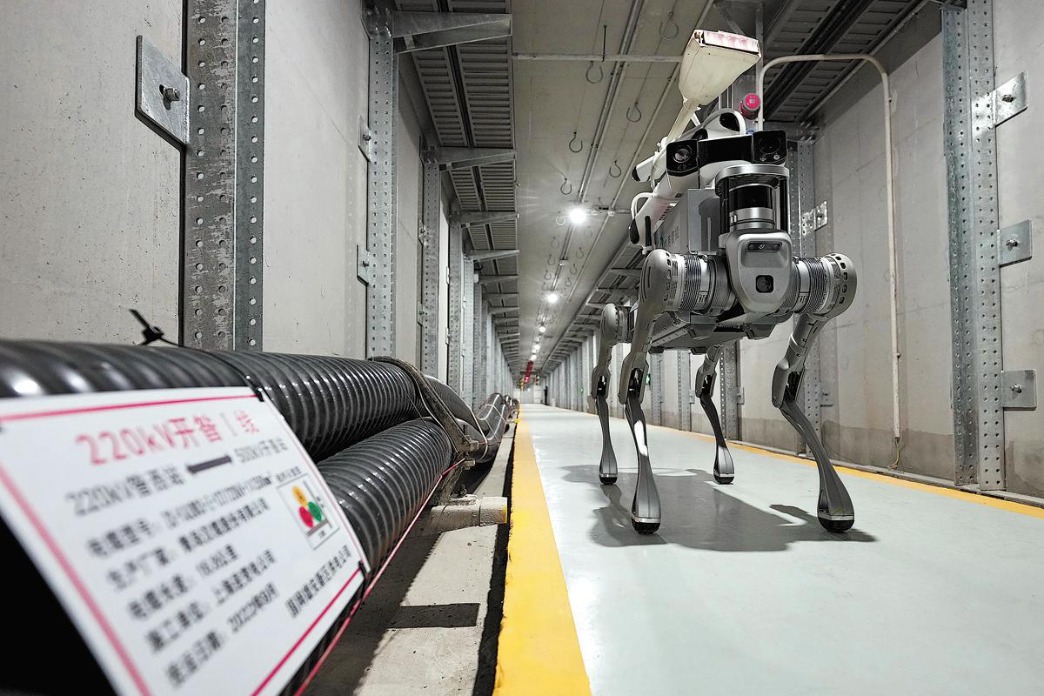US firm's AI tech ban set to inspire homegrown innovation
Experts say move to backfire as well-placed Chinese companies ready to accept challenge
By Fan Feifei and Cheng Yu | China Daily | Updated: 2024-07-25 06:54
Ending dependency
Zhou, from the 360 Security Group, said OpenAI's move to restrict access to its API services in China will force domestic developers and AI companies to choose local AI model builders who have been vying for a bigger slice of the market. He added that the gap between domestic LLMs and ChatGPT has gradually narrowed.
Wu Hequan, an academician of the Chinese Academy of Engineering, said that the number of large models in China ranks high globally, and there isn't a "significant difference" in the performance between these large models and their foreign counterparts.
"While OpenAI's large models are no longer available in China, many Chinese large models are open-source and their prices have dropped considerably to be attractive to users," he said.
In addition, many Chinese companies enable developers to migrate more easily without making any "extra" modifications.
AI startup MiniMax, for instance, launched what it called a "zero-cost nanny-style" migration solution, where users can migrate through just one click and free use of its MOE architecture large model.
Many of the LLMs developed by Chinese companies have been able to rival GPT-4, said Liu Qingfeng, chairman of Chinese AI company iFlytek, while emphasizing the significance of building LLMs that are independently developed and controlled by China.
Only an independent and prosperous ecosystem can ensure a bright future for China's AI industry, he said. "We should scientifically and rationally understand the overall gap between China and the US in large models while having the confidence to catch up quickly," Liu said.
The company recently unveiled its latest LLM Spark-Desk V4.0, which outperforms GPT-4 Turbo in the fields of text generation, language understanding, knowledge questioning and answering, logical reasoning, and mathematics, Liu said.
Zhang Xiaorong, head of the research institute at manufacturing company Deep Innovation based in Shenzhen, Guangdong province, said OpenAI's ban will have an impact on some local enterprises and developers that rely on its technology as they will have to make adjustments and switch to domestic AI platforms.
However, the ban will also drive Chinese companies to take their own LLM development path, step up innovation, and contribute to the growth of the domestic AI sector, Zhang said.
"Domestic AI companies should increase capital input in research and development, optimize algorithms, and improve data-processing capabilities, as well as strengthen cooperation with research institutions to catch up with their US rivals," he added.
Liu Xingliang, director of the research institute of consultancy Data Center of China Internet, said while the ban may have a short-term impact on some Chinese companies, it also provides an opportunity for domestic LLM companies to test themselves. "It is expected to propel domestic enterprises to increase their investment in independent R&D, and promote independent innovation and development of AI technology in China," he said.
Amid rising geopolitical tensions and the United States' attempts to suppress China's chip and other high-tech areas, Liu said more Chinese companies will choose domestic large models to avoid potential disruption and risks.
He expects the government to introduce more policy incentives to support the development and promotion of domestic large models, and encourage LLM startups to independently advance their own core technologies.
Guo Tao, deputy head of the China Electronic Commerce Expert Service Center and an expert on the AI sector, said the ban will drive technological advances in homegrown LLMs and enhance Chinese companies' global competitiveness.
"In the long run, the move might be conducive to creating a more diverse and balanced global AI ecosystem," Guo added.
Major advantages
China has made significant progress in developing AI technology. It is now home to more than one-third of the world's LLMs, according to a white paper released by the China Academy of Information and Communications Technology earlier this month.
The number of LLMs worldwide has reached 1,328, with 36 percent from China, the second-largest after the US, which accounts for 44 percent of the total.
By the first quarter of this year, there were nearly 30,000 AI companies worldwide, with the US making up 34 percent, and China 15 percent, the white paper said.
The revenue of China's AI industry is estimated to reach 1.73 trillion yuan ($237.9 billion) by 2035, accounting for 30.6 percent of the world's total, according to market research firm CCID Consulting.
Wang Peng, a researcher at the Beijing Academy of Social Sciences, said, "China's major advantages in developing AI lie in abundant data resources and diversified industrial application scenarios, while the US has taken the lead in basic AI research, chips, algorithms and other crucial technologies, as well as a sound innovation ecosystem."
Chinese enterprises should pool more resources to improve the quality of data required to train LLMs, cultivate AI talent, and expand cooperation with leading international AI companies, Wang said. More efforts are needed to make breakthroughs in core technologies covering AI chips and cloud servers, he added.
Training AI models imposes massive requirements on computing capacity, which will boost the development of the computing power industry, said Pan Helin, a member of the Ministry of Industry and Information Technology's Expert Committee for Information and Communication Economy.
More efforts are needed to beef up independent innovation abilities in the computing power of chips and programming software, Pan said. Investment should also be increased in basic scientific research — including mathematics, statistics and computer science — to narrow the gap with leading foreign competitors as competition in the global AI industry steps up, he added.
Price reductions
To accelerate the commercial use and popularization of AI technology, a string of major Chinese tech companies have recently announced significant price reductions on major LLM products.
Alibaba Cloud, for instance, slashed the price of its Qwen-Long LLM by a staggering 97 percent. In terms of performance, the LLM is claimed to be in the same league as OpenAI's GPT-4.
Baidu said its LLMs, including Ernie Speed and Ernie Lite, both launched earlier this year, are available free of charge for all enterprise users.
The lite version of Tencent's Hunyuan LLM is now free of charge, while prices of the standard versions have been slashed by 50 to 87.5 percent.
"When LLMs can become very cheap and available at any time for people to use, and without worrying about investment output, they will become akin to infrastructure, just like water and electricity. Under such circumstances, Chinese LLM companies will also have greater room for development," said Zhang Peng, CEO of Zhipu AI.
The technological strengths, application scenarios and training costs of AI models vary among different LLM companies, which leads to differences in pricing tactics, said Zou Debao, deputy general manager of AI and big data research at market research firm CCID Consulting.
Zou said the price war will likely squeeze profit margins of some LLM startups, while large Chinese LLM developers will further consolidate their dominant positions, expand market share, and grab more clients amid increasingly fierce competition.
Zhao Gang, head of CIO Manage, a Beijing-based digital economy market consultancy, said the AI model price cuts will boost the rapid growth of the LLM sector, and motivate companies to beef up independent innovation to roll out more large models for commercial applications.
Contact the writers at fanfeifei@chinadaily.com.cn
























